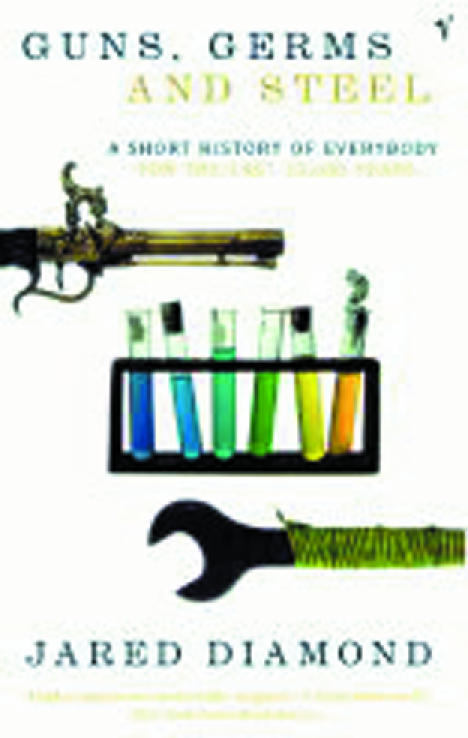Jared Diamond
Vintage, £8.99, pp 480 
ISBN 0 09 930278 0
———————
Rating: ★★★
“Why is it that you white people developed so much cargo and brought it to New Guinea, but we black people had little cargo of our own?”
Jared Diamond, a professor of physiology who also writes about ecology and evolutionary biology, has written this book in response to the above question. The 400 pages wade through 13 000 years of history to explain why the Spanish conquistador Francisco Pizarro destroyed the Atahuallpa’s Aztec empire so quickly, as well as why the development of so much “cargo” occurred in Europe rather than in New Guinea.
The author summarises the main explanation as: “History followed different courses for different people because of differences between people’s environments, not because of biological differences among the peoples themselves.” Examples from places as diverse as the Fertile Crescent, Mesoamerica, and Western Australia are then used to support this.
The climate and east-west axis of the Eurasian land mass allowed a unique collection of flora and fauna to develop. Of the world’s 56 heaviest wild grass seeds, 33 are found on the main Eurasian land mass. Eurasia was also advantaged by possessing 72 mammalian candidates for domestication. The abandoning of the hunter-gatherer lifestyle allowed permanent settlements to develop, leading to the evolution of disease and freeing sections of the population from producing their own food. By the 15th and 16th centuries, Europe had overtaken China in terms of colonising technology. Competition between European neighbours prevented a single edict halting any innovation deemed undesirable, unlike in China, which had turned its back on some advancing technologies.
Europe could conquer the New World because of the Old World technology of the guns and steel of the book’s title. However, the lethal nature of the Europeans’ germs, especially smallpox, made them possibly the most important of the three factors. The author argues that the advantages conferred by these factors were caused by an accident of geography, rather than biological superiority.
Throughout the book Jared Diamond keeps returning to New Guinea, a country that he has studied and explored in great detail. His insistence on applying explanations to New Guinea casts doubt on his own, and other people’s, theories and eventually bored me. However, while not necessarily agreeing with all that it says, I found Guns, Germs and Steel an interesting and informative account of the rise of human civilisation and of the reasons for the arrival of “white cargo” in New Guinea.


